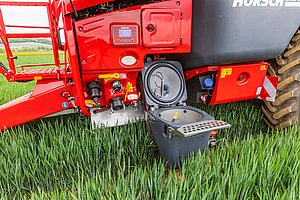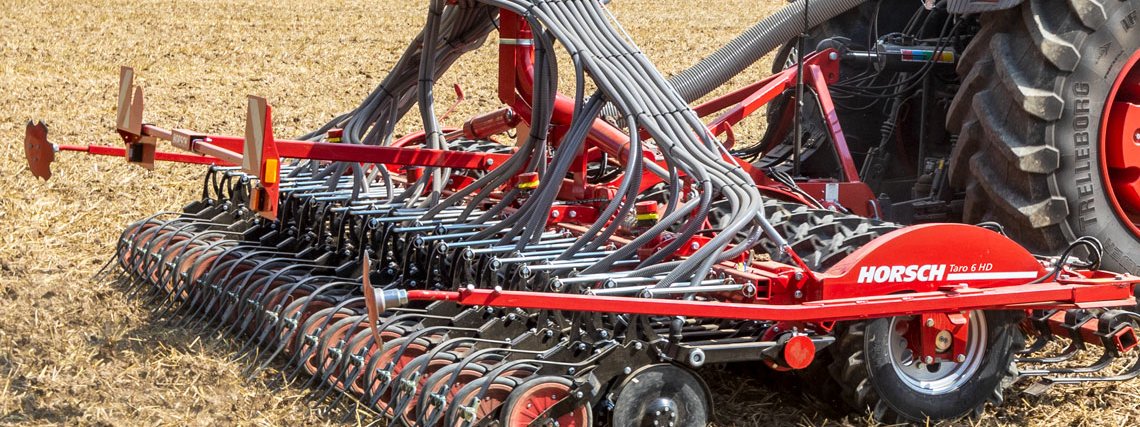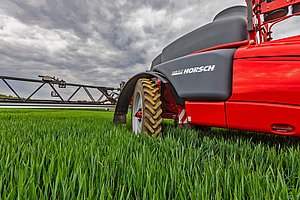Machinery co-operative with a PE sprayer and a lot of crops – How does it work? (Part 2)
Average reading time approx. 6 minutes
The arable farm of the Schule Uemmingen family is located in Lower Saxony, about 18 km north of Braunschweig. A farm with a long history that has its origin in Bochum. Now the third generation of the family is living in Gifhorn. We want to take the opportunity to present a farm that deliberately opted for a sprayer with a PE tank despite the numerous crops the farm grows. But first of all, some background information about the farm:
Hinrich Schulte Uemmingen runs the arable farm. After having passed his A levels he trained as a farmer on two farms – one of them a varied arable farm and the other one a pig farm.
After having finished his training as a farmer he studied in Göttingen and graduated with a Master of Science in agricultural sciences. In 2016, he joined the parental farm.
The farm of the Schulte Uemmingen family
In addition to the arable family farm a livery stable with a riding school is located on the premises which is also run by the family. Together with the independent farm of his uncle (the Löbbecke family in Ribbesbüttel) the family farms just under 700 hectares with heavily changing soils – from mainly sandy soils with 20 soil values to heavy soils with up to 70 soil values. The challenges on these changing soils are enormous.
To cultivate these soils in an optimum way and also to improve as well as to maintain the quality of the fields, the co-operative went for different rotations with different crops: rye, maize, rape and potatoes on lighter sites and wheat barley and sugar beets on soils with higher soil quality.
Rye | 25% |
| Maize | 25% |
| Wheat | 15% |
| Sugar beet | 10% |
Rape | 5% |
| Barley | 5% |
| Potatoes | 5% |
Greening | 5% |
| Grassland | 5% |
Machinery co-operative with the Löbbecke family
Due to the geographical proximity and the varied rotation the machinery co-operative with his uncle’s farm already started more than 25 years ago. All machines that are relevant for the cultivation and the care of the crops were purchased by this machinery co-operative. Due to the good and longtime experience with the machinery co-operative, they, in 2017, decided to invest in a new and more efficient plant protection sprayer.
The decision for the HORSCH Leeb 6 LT was quickly taken, the reasons however, were manifold.
In the sector of 6,000 litres sprayers HORSCH offers the 6 LT as well as the 6 GS. They discussed about both machines. The decision to go for the PE tank was quickly clear to the co-operative. For over all these years they had never had negative experiences with plastic and PE tanks. But they were well aware of the fact that with regard to the varied rotation of the co-operative a simple and exact cleaning was indispensable.

Continuous inside cleaning as a basic requirement
The continuous inside cleaning and the fully electrical control system CCS Pro facilitates the cleaning of the sprayer and makes it very comfortable for the user. Schulte Uemmingen has been using this system for three years and he has never noticed any damages to his crops. Even when he changes between crops with critical tank mixtures, e. g. when using sulfonylurea, the cleaning always is reliable and exact.
To work efficiently during the peak periods for plant protection, the post-emergence crops in sugar beets on the own farm as well as on the Löbbecke farm are sown on the same day if possible. This generates higher efficiency and a more homogeneous development. Moreover, the work peaks can be equalised as the Schulte Uemmingen farm grows rape which requires spraying mainly in autumn and spring and the Löbbecke farm grows potatoes and thus requires the sprayer mainly in summer. In this respect, too, the continuous inside cleaning turned out to be unbeatable. Cleaning is carried out fast. Everyone can rely on the plant protection sprayer being completely clean afterwards.
For complex tank mixtures a cleaner is used that due to the circulation cleans the sprayer up to the nozzle and can then be used again for rinsing. The continuous inside cleaning starts by pushing a button at the terminal. The user can select whether he wants an intensive cleaning or if he wants to clean only parts of the sprayer, e. g. the boom. Thus, the cleaning process can always be monitored in an optimum way and the user can keep an eye on it. The system, of course, also assists for example with regard to the time the nozzles are to be opened. It is an absolutely safe system which offers the user a lot of comfort.
Efficient use of the sprayer due to good communication
Due to the good communication between the two farm managers the sprayer can be used very efficiently, says Schulte Uemmingen. So far, there have not been any problems. Thanks to the machinery co-operative the cost-benefit calculation also is unbeatable. Schulte Uemmigen quickly answers the questions how he would describe his sprayer: „one of the most efficient and most reliable machines.”
We already described the two tank versions and gave you a practical example of how a PE tank is used. In the third part of our series, we want to present you another practical experience. A farmer from Northern Hesse will explain why he opted for a stainless steel tank.
His reasons? Stay tuned!

